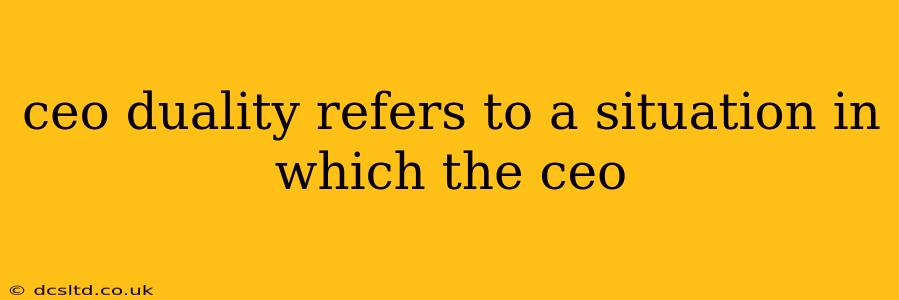CEO duality refers to a situation where the same individual holds both the positions of Chief Executive Officer (CEO) and Chairman of the Board of Directors. This concentrated power structure, while seemingly efficient, presents a complex array of advantages and disadvantages that significantly impact a company's governance, performance, and overall success. This article will delve into the nuances of CEO duality, examining its implications and addressing frequently asked questions.
What are the arguments for and against CEO duality?
The debate surrounding CEO duality is multifaceted and often hinges on the specific context of the company. Proponents argue that combining the roles streamlines decision-making, fosters a unified vision, and enhances accountability. The CEO, already deeply involved in the company's operational aspects, can directly translate strategic direction into action without the potential friction of navigating separate leadership entities. This can be particularly advantageous in smaller companies or during periods of rapid growth or crisis.
Conversely, critics highlight the inherent risks associated with concentrating so much power in a single individual. The potential for unchecked authority, diminished oversight, and a lack of independent board oversight are major concerns. Without a separate Chairman to challenge decisions and provide an independent perspective, the risk of poor decision-making, conflicts of interest, and a lack of transparency increases. This can ultimately lead to decreased shareholder value and corporate governance failures.
What are the potential benefits of a dual CEO and chairman role?
As mentioned, streamlined decision-making is a key perceived benefit. A single leader can quickly respond to market changes and opportunities, fostering agility and efficiency. This unified leadership can also create a strong sense of direction and purpose throughout the organization, fostering alignment and improving morale. In smaller companies, the reduced administrative overhead and improved communication can be particularly beneficial.
What are the potential drawbacks of a dual CEO and chairman role?
The concentration of power is the most significant drawback. A lack of independent oversight increases the risk of autocratic leadership, potentially leading to poor strategic decisions and inadequate risk management. This can also stifle innovation and dissent, preventing the emergence of alternative perspectives and hindering the organization's ability to adapt. Further, the potential for conflicts of interest is heightened, especially concerning compensation and executive perks.
Does CEO duality affect corporate governance?
Significantly. CEO duality directly impacts corporate governance structures, often weakening the system of checks and balances intended to protect shareholder interests. Independent board members play a crucial role in overseeing management and providing objective evaluations, and their influence is diminished when the CEO also serves as Chairman. This lack of separation can lead to reduced board effectiveness and a greater likelihood of agency problems, where management acts in its own interest rather than in the best interests of the shareholders.
How does CEO duality affect shareholder value?
Empirical research on the impact of CEO duality on shareholder value is mixed. Some studies suggest a negative correlation, indicating that companies with dual leadership structures experience lower shareholder returns. This is often attributed to the risks mentioned above: poor decision-making, increased agency costs, and reduced accountability. However, other studies have found no significant relationship or even a slightly positive correlation, suggesting that the impact can vary depending on factors such as company size, industry, and the specific skills and experience of the individual holding both roles. The context matters significantly.
What are some examples of companies with CEO duality?
While less common in large, publicly traded companies due to increased scrutiny of corporate governance, smaller organizations or those undergoing significant change might opt for CEO duality. Specific examples would require research into current company leadership structures and are subject to change. It's more important to understand the implications of this structure than to focus on specific companies at any given time, as leadership structures evolve frequently.
Conclusion
The question of CEO duality is a complex one with no easy answers. While it can offer benefits in certain circumstances, the potential downsides related to corporate governance and shareholder value are substantial. A careful evaluation of the specific circumstances of each company, including its size, industry, and the capabilities of its leadership, is crucial when considering whether to adopt this leadership structure. Ultimately, the decision should be guided by a commitment to strong corporate governance and a focus on maximizing long-term shareholder value.
